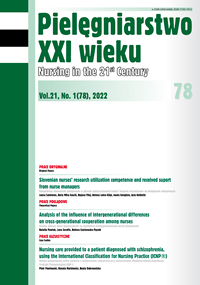Mobbing i jego wpływ na zdrowie wybranej próby pielęgniarek w Republice Czeskiej
DOI:
https://doi.org/10.2478/pielxxiw-2022-0008Słowa kluczowe:
mobbing, zdrowie pielęgniare, NAQ-R, GHQ-28Abstrakt
MOBBING I JEGO WPŁYW NA ZDROWIE WYBRANEJ PRÓBY PIELĘGNIAREK W REPUBLICE CZESKIEJ
Wprowadzenie. Mobbing to problem systemowy, który dotyka wszystkie sektory zawodowe, w tym sektor ochrony zdrowia.
Pracownicy służby zdrowia to grupa narażona na wysoki poziom stresu, a tym samym na ryzyko wystąpienia negatywnych sytuacji w miejscu pracy. Częstość występowania mobbingu wśród pielęgniarek jest wysoka. Mobbingowane pielęgniarki częściej cierpią na
stresujące bóle głowy, bezsenność, niepokój i zgłaszają objawy depresji.
Cel pracy. Celem badania było określenie wskaźnika mobbingu w wybranej próbie pielęgniarek oraz opisanie postrzegania zdrowia przez pielęgniarki. Ustalenie, czy istnieje statystycznie istotny związek między częstością występowania mobbingu, postrzeganym stanem zdrowia, wiekiem pielęgniarek i stażem pracy.
Materiał i metody. Przeprowadzono opisowe badanie przekrojowe. Wykorzystano standaryzowane narzędzia Negative Acts
Questionnaire-Revised oraz General Health Questionnaire-28. Grupę badawczą stanowiły pielęgniarki pracujące na oddziale intensywnej opieki medycznej wybranych placówek medycznych.
Wyniki. W badaniu wzięło udział 715 pielęgniarek ze wszystkich regionów Republiki Czeskiej. Wskaźnik doświadczenia pielęgniarek
z negatywnymi czynami w miejscu pracy wynosi 79.30%. Narażone na mobbing pielęgniarki częściej zgłaszają zaburzenia zdrowia,
zwłaszcza w zakresie objawów somatycznych, lęku i bezsenności. Większą liczbę negatywnych czynów zgłaszają młodsze pielęgniarki z krótszym stażem ogólnej praktyki pielęgniarskiej.
Wnioski. Potwierdzono występowanie mobbingu w wyselekcjonowanej próbie pielęgniarek w Republice Czeskiej. Mobbingowane
pielęgniarki dostrzegają i zgłaszają pogarszający się stan zdrowia.
Bibliografia
1.Topa G, Moriano JA. Stress and nurses’ horizontal mobbing: Moderating eff ects of group identity and group support. Nursing outlook. 2013; 61(3): 25-31. https://doi.org/10.1016/j.outlook.2013.03.002.
2. Bowling NA, Beehr TA. Workplace harassment from the victim’s perspective:
A theoretical model and meta-analysis. Journal of Applied Psychology. 2006; 91(5):998-1012. https://doi.org/10.1037/0021-9010.91.5.998
3. Durmus SC, Topcu I, Yildirim A. Mobbing Behaviors Encountered by Nurses and their Eff ects on Nurses. International Journal of Caring Sciences. 2018; 11(2): 905-915. http://internationaljournalofcaringsciences.org/docs/32_durmus_original_10_2.pdf.
4. Zachariadou T, Zannetos S, Chira SE, et al. Prevalence and Forms of Workplace Bullying Among Health-care Professionals in Cyprus: Greek Version of “Leymann Inventory of Psychological Terror” Instrument. Safety and Health at Work. 2018; 9(3): 339-346. https://doi.org/10.1016/j.shaw.2017.11.003.
5. Myers G, Cote-Arsenault D, Worral P, et al. A cross-hospital exploration of nurses’´ experiences with horizontal violence. Journal of Nursing Management. 2016; 24: 624-633. https://doi.org/10.1111/jonm.12365.
6. Difazio RL, Vessey, JA, Buchko OA, et al. The incidence and outcomes of nurse bullying in the Russian Federation. International Nursing Review. 2019; 66: 94-103. https://doi.org/10.1111/inr.12479.
7. Einarsen S, Hoel H, Notelaers G. Measuring exposure to bullying and harassment at work: Validity, factor structure and psychometric properties of the Negative Acts Questionnaire-Revised, Work & Stress. 2009; 23(1): 24-44. https://doi. org/10.1080/02678370902815673
8. Olweus D. Bully/victim problems in school. Basic facts and an eff ective intervention programme. [In:] Einarsen S, Hoel H, Zapf D, Cooper CL (Eds.). Bullying and emotional abuse in the workplace. London: Taylor & Francis. 2009; 62-78. ISBN 0-415-25359-4.
9. Aksakal FN, Karaşahin EF, Dikmen AU, et al. Workplace physical violence, verbal violence, and mobbing experiencedby nurses at a university hospital. Turkish journal of medical sciences, 2015; 45(6): 1360-1368. https://journals.tubitak.gov.tr/ medical/abstract.htm?id=17627
10. Ekici D, Beder A.The eff ects of workplace bullying on physicians and nurses.
Australian Journal of Advanced Nursing, 2014; 31(4), 24-33. https://www.ajan.com. au/archive/Vol31/Issue4/3Ekici.pdf
11. Chatziioannidis I, Bascilla FG, Chatzivalsama P, et al. Prevalence, causes and mental health impact of workplace bullying in the Neonatal Intensive Unit Care environment. BMJ Open. 2018; 8: e018766. http://dx.doi.org/10.1136/bmjopen-2017-018766.
12. Figueiredo-Ferraz H, Gil-Monte PR, Olivares-Faúndez VE. Influence of mobbing (workplace bullying) on depressivesymptoms: a longitudinal study among employees working with people with intellectual disabilities. Journal of Intellectual Disability Research. 2015; 59(1): 39-47. https://onlinelibrary.wiley.com/doi/ epdf/10.1111/jir.12084
13. Tatar ZB, Yüksel Ş. Mobbing at workplace–psychological trauma and documentation of psychiatric symptoms. Archives of Neuropsychiatry. 2019; 56(1): 57-62 doi: 10.29399/npa.22924.
14. Beňo P. Můj šéf, můj nepřítel?. Šlapanice: Era; 2003: 181 s. Kariéra. ISBN 80-86517-34-9.
15. Goris S, Ceyha, O, Tasci S, et al. Mobbing against Nurses in Turkey: How Does it Aff ect Job Satisfaction. International Journal of Caring Sciences. 2016; 9(3): 810-818. http://internationaljournalofcaringsciences.org/docs/9_goris_ABSTRACT_9_3.pdf.
16. Haddad LM, Annamaraju P, Toney-Butler TJ. Nursing shortage. StatPearls; 2020. [Internet]. https://www.ncbi.nlm.nih.gov/books/NBK493175/
17. Johnson AH, Benham‐Hutchins M. The infl uence of bullying on nursing practice errors: a systematic review. AORN journal. 2020; 111(2): 199-210. https://doi. org/10.1002/aorn.12923
18. Özkan Şat S, Akbaş P, Yaman Sözbir Ş. Nurses’ exposure to violence and their professional commitment during the COVID‐19 pandemic. Journal of clinical nursing. 2021; 30(13-14): 2036-2047. https://doi.org/10.1111/jocn.15760.
19. Al-Ghabeesh H, Qattom H. Workplace bullying and its preventive measures and productivity among emergency department nurses. Israel Journal Health Policy Research. 2019; 8(44): 1-7. https://doi.org/10.1186/s13584-019-0314-8.
20. Kozáková R, Bužgová R, Zeleníková R. Mobbing of nurses: prevalence, forms
and psychological consequences in the Moravian Silesian region. Czechoslovak
Psychology. 2018; 62(4): 316-329. http://cspsych.psu.cas.cz/result.php?id=1022
21. Al-Sagarat A, Qan´ir Y, Al-Azzam M, et al. Assessing the impact of workplace bullying on nursing competences among registered nurses. Jordanian Nursing and Health Sciences. 2016; 18(2): 172-179. https://doi.org/10.1111/nuf.12253.
22. Carter M, Thompson M, Crampton P, et al. Workplace bullying in the UK NHS: a questionnaire and interview study on prevalence, impact and barriers to reporting.
BMJ Open. 2013. 3:e002628. http://dx.doi.org./10.1136/bmjopen-2013-002628.
Pobrania
Opublikowane
Numer
Dział
Licencja
Prawa autorskie (c) 2022 Autorzy

Utwór dostępny jest na licencji Creative Commons Uznanie autorstwa 4.0 Międzynarodowe.




